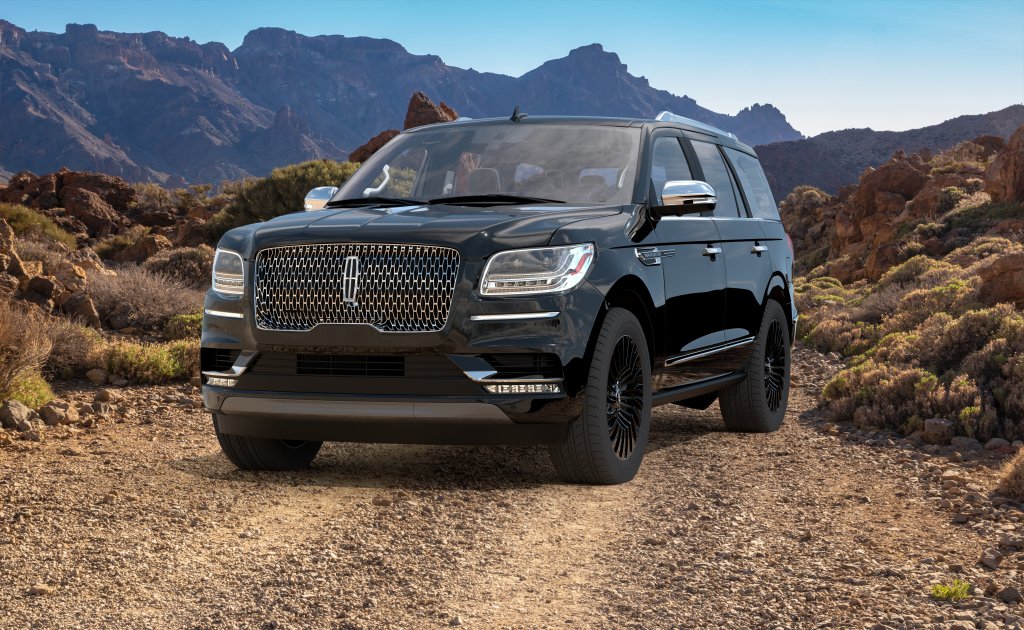While full-size luxury SUVs started in the 1980s with the leather-clad and wood-tone-paneled Jeep Grand Wagoneer, the 1998 introduction of the Lincoln Navigator gave the movement traction. It all comes down to timing. America wasn’t quite ready to embrace top-tier SUVs 40 years ago. But this changed with the approach of the 21st century and an SUV market about to explode.
The idea behind the Navigator was nothing new. Take the utilitarian Ford Expedition, give it a fancier body, and dress up the cabin with leather and other niceties. But equating luxury with quality and reliability isn’t the best approach. The Lincoln Navigator has its share of best and worst model years. And knowing which Navigators are deserving of a thumbs up or a thumbs down is helpful, whether you’re shopping for one of these upscale family haulers or already have one in the driveway.
Keep reading as we explore the answers that come from a review of Lincoln Navigators with a FIXD sensor. This data produces the FIXD Reliability Score, which measures engine dependability. In addition, we examine published data covering safety scores, fuel economy, and resale value.
Lastly, FIRIS (FIXD Internet Review Index Score) is incorporated into the results. This compilation of online feedback and ratings for a specific model year provides insights from owners and professional car reviewers.
Here’s a brief look at the results. We’ll get into a model year breakdown later on.
|
Best Years |
Why? |
|
Near-perfect engine reliability scores, impressive safety results |
|
|
Good combination of engine reliability and value. Solid F.I.R.I.S. rankings |
|
|
Impressive safety score |
|
Worst Years |
Why? |
|
Sub-par engine reliability |
|
|
First year of the second generation, poor engine reliability |
|
|
First year of the third generation (2007), poor engine reliability |
|
|
Loe engine reliability scores |
|
|
First year of the fourth generation |
Note: the 2021-2023 model years are not included due to limited data. This may change in the future.
Lincoln Navigator Engine Reliability Score, Safety Ratings, MPG, Value v.s. Value for the Money, and F.I.R.I.S. – Year by Year
Our determination for the best and worst Lincoln Navigator years comes from the following:
- FIXD Reliability Scores (engine reliability)
- National Highway Transportation Safety Administration (NHTSA) safety ratings
- Environmental Protection Agency (EPA) fuel economy estimates
- Kelley Blue Book (KBB) market value compared to yearly upkeep costs (based on RepairPal.com data).
- F.I.R.I.S. rankings (a summary of online ratings and reviews)
Priority is given to engine reliability—a car is pretty much worthless if there are significant problems under the hood. That said, the FIXD Reliability Score for a specific model year doesn’t have to be perfect (10 out of 10) to receive a positive recommendation. For one, no Navigator year scored a 10 (although there are 8s and 9s). And lower FIXD Reliability Scores (3-6) are common in older vehicles; the Navigator is no exception.
So, the reality is that buying an older (and cheaper) Navigator means accepting less-than-ideal engine reliability. However, we looked for other positives (such as safety, MPG, and value) to offset a mediocre FIXD Reliability Score. For instance, the 2004 Navigator receives an underwhelming 3 for engine reliability but is only one of two model years to receive a perfect crash test score from NHTSA. We’ll explain this in more detail later.
Lastly, we give the first year of an all-new design the thumbs down by default. History shows that inaugural editions (whether for a completely new vehicle or a new generation) are often filled with gremlins and other “teething pains.” Avoiding these model years is playing the odds in your favor.
If you’re curious about how other large SUVs stack up, check out our best and worst year articles on the GMC Yukon, Chevrolet Tahoe, Chevrolet Suburban, and Toyota Sequoia.
If you’re in the market for a car, take a look at our article on the USA’s most reliable and cheapest to repair cars in the U.S. Don’t get stuck with a lemon; use our data to help you shop.
Engine Reliability Score – Over The Years
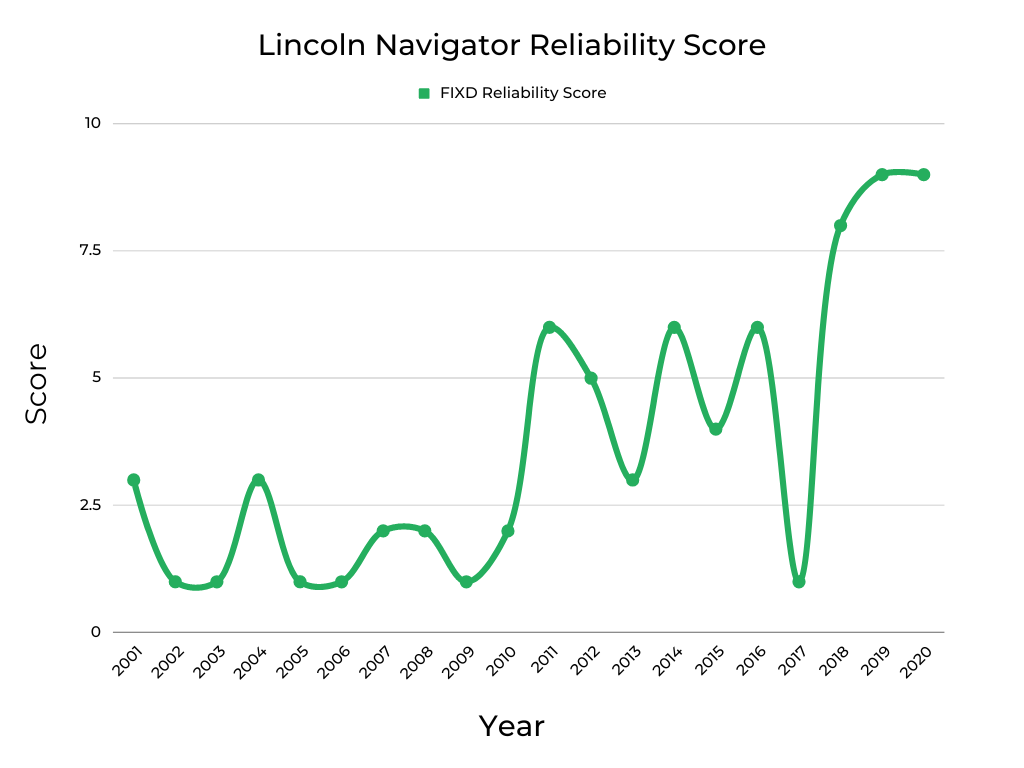
The graph highlights the FIXD Reliability Score for Lincoln Navigators from 2001-2020. This is a measurement, which is weighted by mileage, to check engine light frequency in Navigators with a FIXD sensor. 10 indicates the best possible score, with one being the worst. 5 is average.
It’s unsurprising to see low scores for old Navigators; age can take a toll on even the most reliable car. What’s particularly curious is that no Navigator model year received a 10 for engine reliability, even among more recent examples.
This tells us that regardless of year, Navigators of all ages experience check engine lights. Of course, not every check engine light is a disaster in the making. Sometimes, a loose gas cap is all it takes to trigger a dashboard warning light. Regardless, if you see a specific Navigator model year at the bottom of the FIXD Reliability Score scale, chances are it’s on our worst years list.
Read the Ford Check Engine Light article to learn the most common causes of check engine lights in Fords and similar Lincoln vehicles.
NHTSA Safety Score – Over The Years
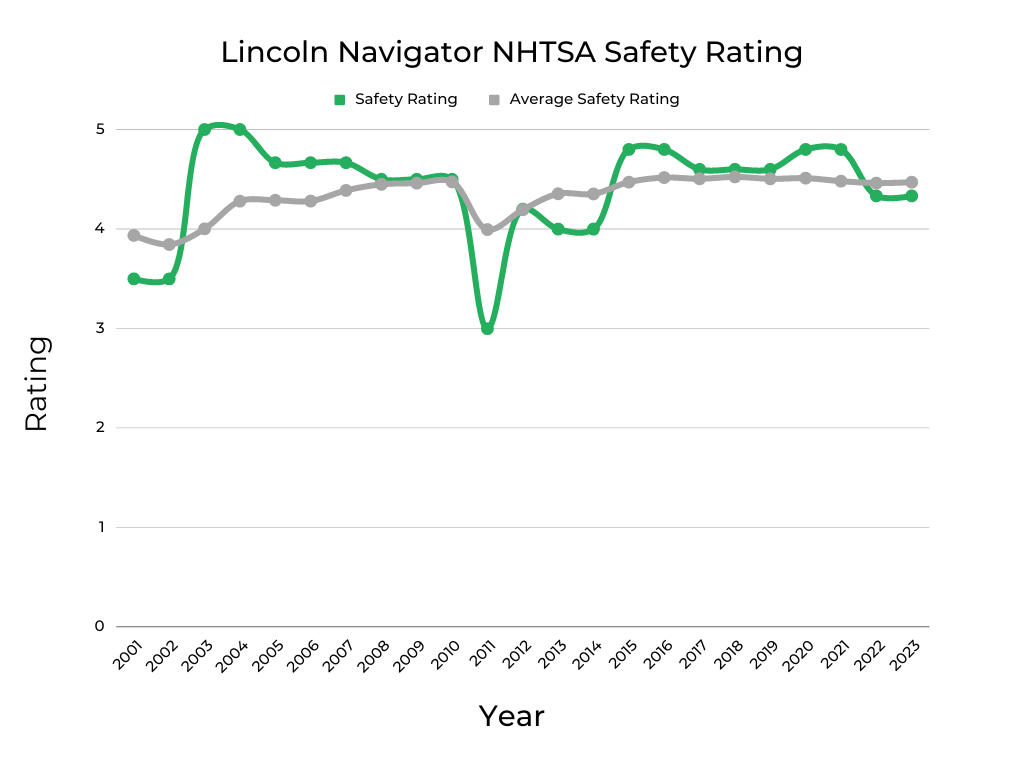
Thinking that a big, hulking vehicle like a Navigator would do well in government crash tests isn’t far off the mark. Most model years perform well, with the majority scoring at least a 4.0 (out of 5.0), considered a solid safety yardstick.
The 2001-2002 Navigator fails to live up to this standard, one of many reasons these editions don’t pass muster. However, we’re less concerned about the 2011 model year. This marks the start of more stringent NHTSA testing, which many automakers struggled with.
So, while the 2011 Navigator may not measure up to more recent standards, it would have performed quite well under previous testing scenarios. For example, the 2010 Navigator scored a 4.5 (out of 5), an impressive (for the time) result.
There’s another benefit to driving a safe vehicle: it keeps insurance rates low.
If you live in one of the states listed below, we can show you the cheapest vehicles to insure in yours.
| What Used Cars Are the Cheapest To Insure In: |
| Ohio |
| North Carolina |
| Michigan |
| Georgia |
| Texas |
| New York |
| Illinois |
| Pennsylvania |
| California |
MPG – Over The Years
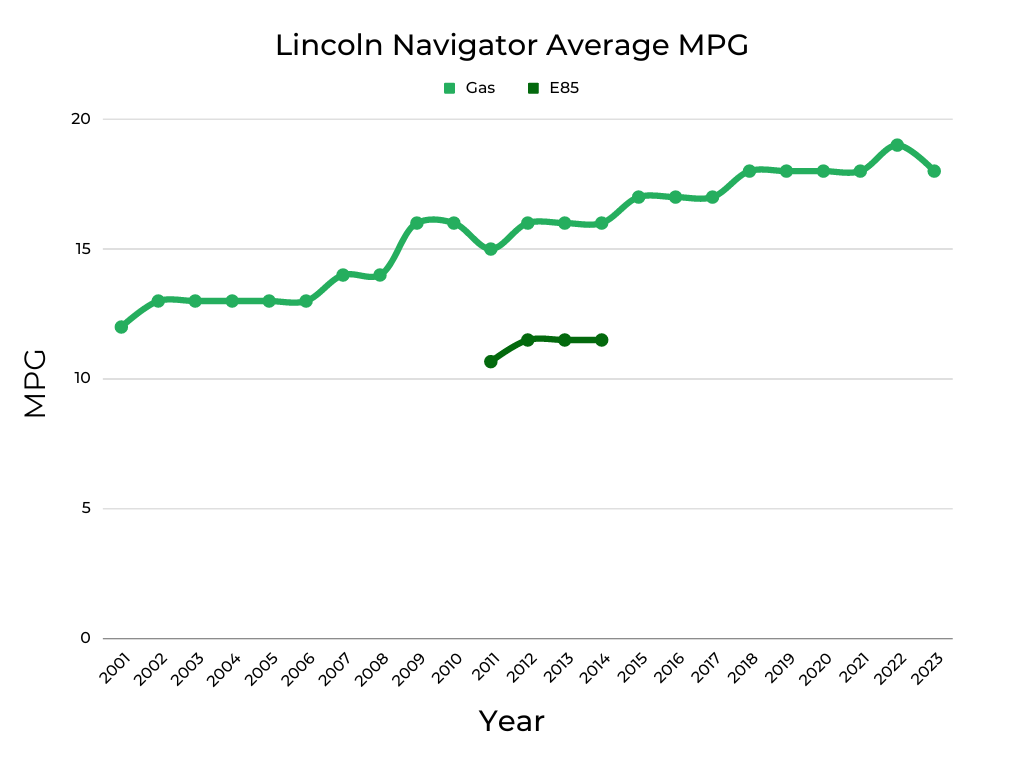
The conversion about fuel economy and jumbo SUVs will be short—no one buys a Lincoln Navigator or similar vehicle to save on gas. As the chart shows, it took Lincoln several years before even hitting an average of 15 MPG was possible.
The 2015 switch to a twin-turbocharged from a V8 helped marginally. Yet, it took a redesign in 2018 to eke out 18 MPG or better with this 5,500-pound beast. Lincoln’s experiment with E85 fuel (85% gasoline, 15% ethanol) proved no better, with fuel economy maxing out at 12 MPG (E85 gas may be cheaper but has less energy, which translates to poor mileage).
Current Market Value of All Lincoln Navigator Years vs. Value for the Money

A car’s resale value can drop if it has a history of excessive repair costs. Fortunately, we don’t see this with the Lincoln Navigator. The average Kelley Blue Book (KBB) market value (green) steadily increases each more recent year. This is precisely how market values should appear over time. There’s a dip in value for the 2014 model year without a particular reason. Perhaps it being the last year of the V8 Navigator has something to do with it.
Yearly maintenance and repair expenses (gray) average $1,089 among the 2001-2019 model years (there’s no expense data for 2020 and later Navigators). Most model years stay close to this figure. Upkeep exceeds this amount by 20% or more for only the 2001, 2003, and 2004 editions, according to RepairPal.
When shopping for a used (make) (model), it’s important to keep in mind that not all vehicles are cared for equally. To protect yourself from lemons, take along a FIXD Sensor on your test drive. FIXD connects to a free app on your smartphone to tell you more about the vehicle you’re checking out, including check engine lights and other hidden issues that the owner or dealership may be attempting to hide. Click here to learn more and get FIXD for only $19.99 (regular price $59)!
F.I.R.I.S. – FIXD Internet Review Index Score– Over the Model Years
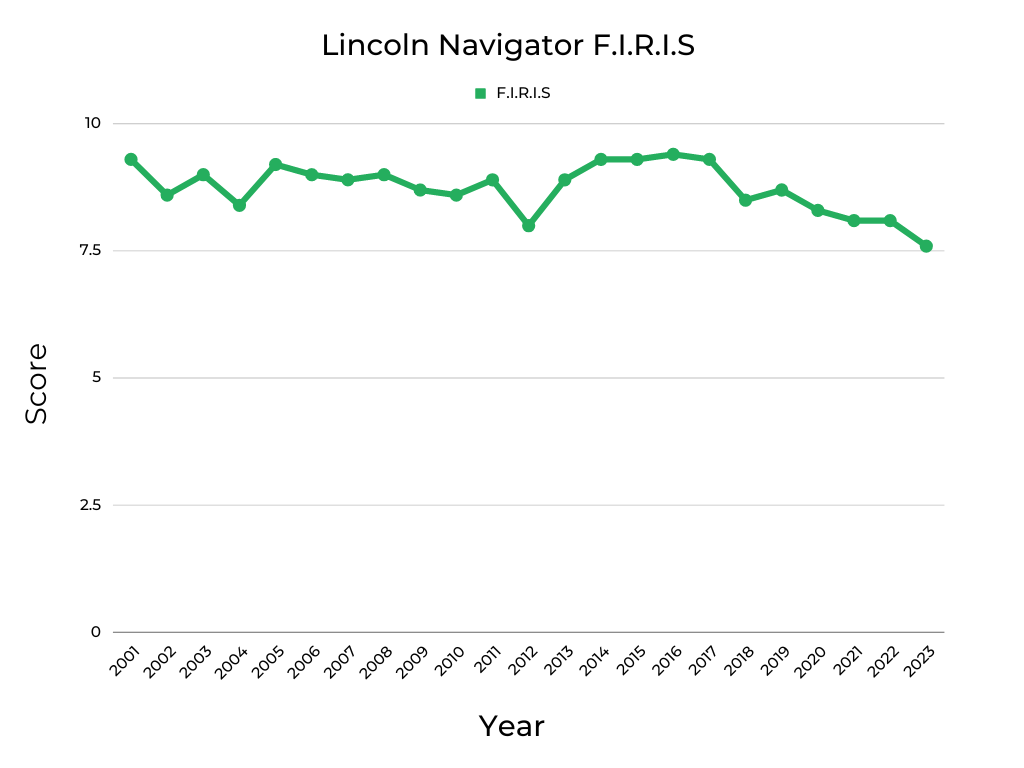
F.I.R.I.S. sounds more complicated than it is. We compile year-specific model ratings from four trusted automotive sites: Cars.com, Edmunds, KBB, and CarGurus. These scores are then averaged and recalculated on a scale of 1-10. Centralizing this information brings together varying viewpoints in an easy-to-understand format.
Overall, reviews are positive, with every Navigator model year scoring at least a 7.6 (out of 10) and all analyzed years averaging an impressive 8.7. Who doesn’t like tooling around in an ultra-plush mega machine?
It’s essential to keep in mind that F.I.R.I.S. ratings are somewhat subjective. The respective auto sites have their own criteria for vehicle ranking, but much of this involves opinion. In other words, knowing a vehicle’s F.I.R.I.S. score is definitely helpful, but it shouldn’t be the sole determiner for choosing a car.
Important Features Timeline
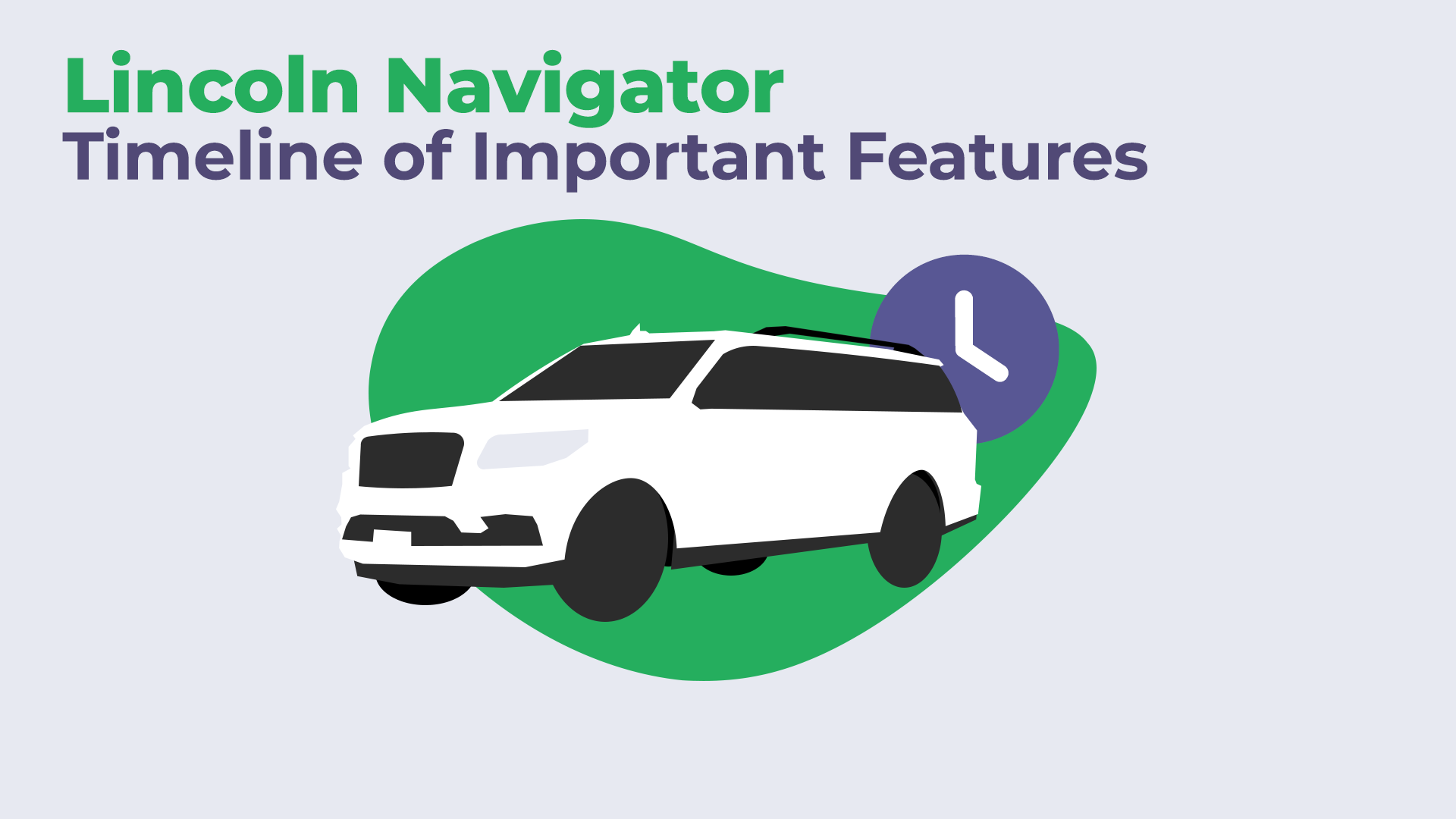
1998: Debut of the Lincoln Navigator
1999: A new engine brings 300 horsepower (up from 230 HP)
2000: Satellite navigation and rear parking sensors are optional
2001: Auxiliary climate control is standard across the lineup
2002: A Limited Edition package is added to the option list
2003: The second-generation Navigator appears
2004: Trims are reduced to two: Luxury and Ultimate
2005: New six-speed automatic transmission and exterior updates are added
2006: No major changes
2007: Debut of the third-generation Navigator
2008: Only one trim is available with standard luxury features like climate-controlled seats
2009: The Sync infotainment system is now standard
2010: Upgraded leather and the programmable My Key are standard
2011: Infotainment features include HD radio and an optional dual-screen rear entertainment system
2012: All Navigators get blind-spot monitoring
2013: No major changes
2014: No major changes
2015: Updates inside and out; a turbocharged V6 replaces the previous V8
2016: Lincoln adds the Sync 3 infotainment system
2017: No major changes
2018: Launch of the fourth-generation Navigator
2019: No major changes
2020: The Co-Pilot360 driver safety system is standard
2021: A Special Edition package is available
2022: The Navigator gets a revised exterior; ActiveGlide hands-free driving is optional
2023: No major changes
The Best Years of the Lincoln Navigator
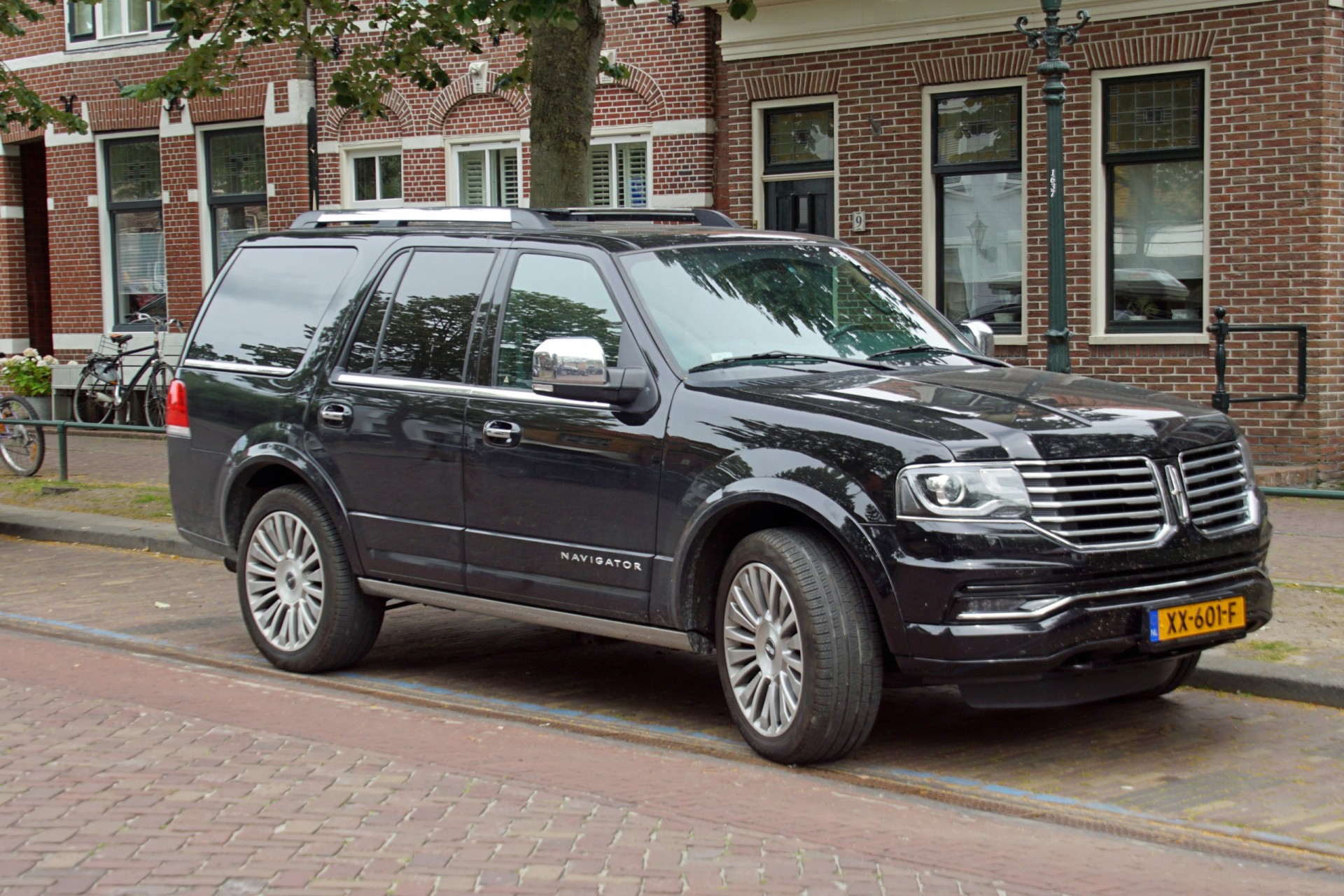
The best years of the Lincoln Navigator are determined by assessing the FIXD Reliability Score, NHTSA safety testing, fuel economy, market value, and F.I.R.I.S. ranking. A look at common diagnostic trouble codes (DTCs) provides further insights into the reliability of the Navigators (just because a particular model year makes the best years list doesn’t mean it’s flawless).
2019-2020 Lincoln Navigator
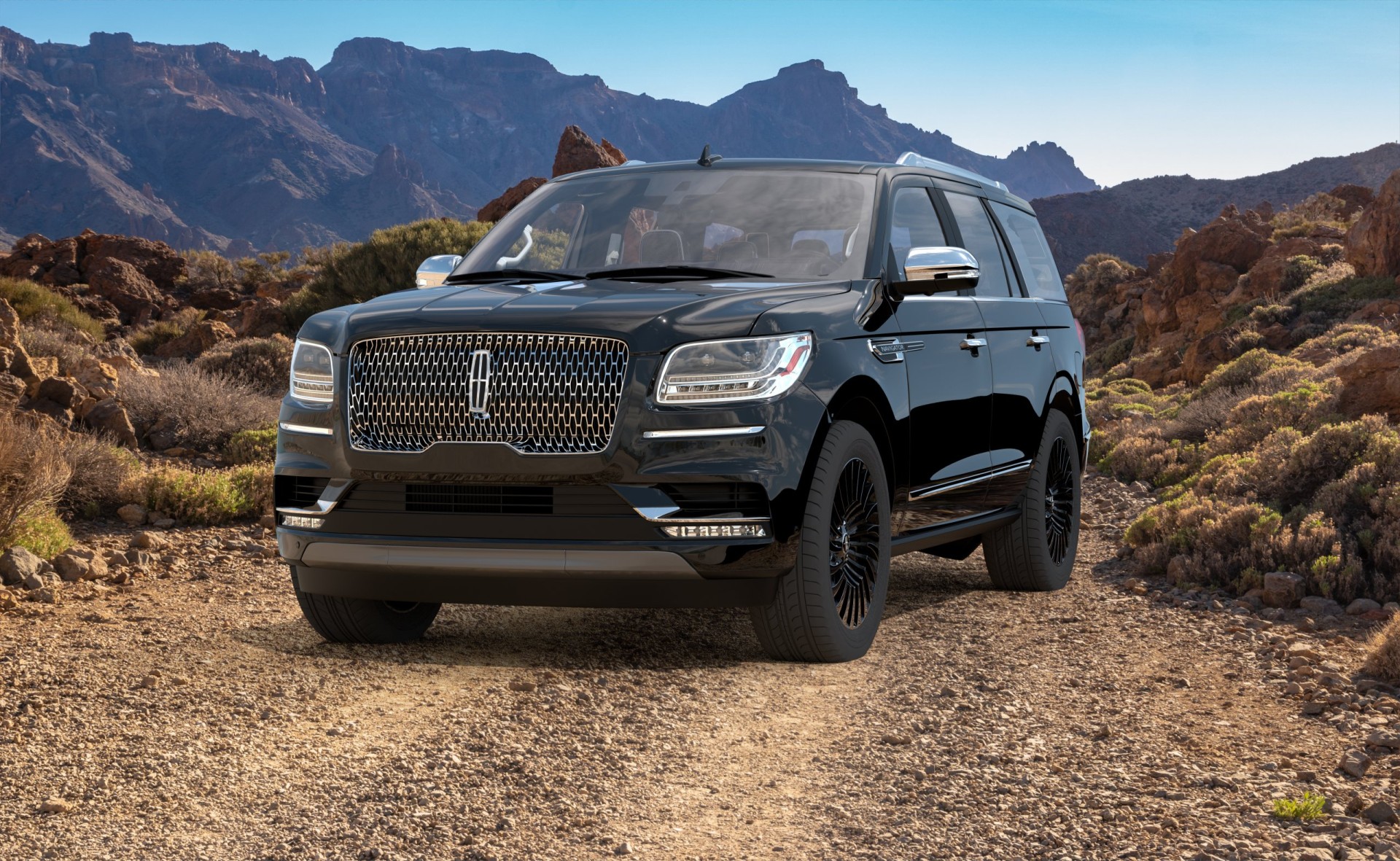
FIXD Reliability Score: 9/10
FIXD Internet Review Index Score (F.I.R.I.S.): 8.3-8.7/10
KBB Value: $41,940-$53,746
Fuel Economy: 18 mpg
RepairPal Average Annual Repairs Total: $1,254 (2019)
Safety Rating: 4.6-4.8/5
Seeing some of the newest Navigators on our best years list is no surprise. These model years are from the current (fourth) generation and may still have warranty coverage. That said, the 2018 Navigator (another part of the fourth generation) doesn’t make the cut—this is covered later.
Not only do the 2019-2020 Navigators receive top FIXD Reliability Scores (9 out of 10) among all model years, but these three-row behemoths get almost reasonable fuel economy (18 MPG). With average annual maintenance and repair expenses of $1,254 (for the 2019 model year), this Navigator is slightly more expensive to keep on the road (the yearly average for all Navigators is $1,089).
Solid F.I.R.I.S. scores (8.3-8.7/10) are also noteworthy.
What’s especially impressive is the very low frequency of diagnostic trouble codes (check engine lights). A handful of 2019 editions encountered a faulty catalytic converter (P0420), which can be expensive to fix (up to $2,400 if the entire system needs replacement). It’s not typical for this to happen on more recent cars, but repairs may fall under the warranty. The 2020 Navigator mostly escapes error codes. FIXD data shows very few incidents (one or two, if any, per code).
Shoppers will also appreciate high safety scores. The 2019 edition scored a notable 4.6 out of 5 in NHTSA testing, while the 2020 received a near-perfect 4.8.
Meanwhile, the 2019 Navigator is subject to four recalls. Fortunately, these are minor issues or applicable to only a few vehicles. There are five recalls for the 2020 model year. Visit the NHTSA recall website to confirm a vehicle’s status.
Buying a 2019 or 2020 Lincoln Navigator will set you back $45,000 or more (the cited KBB values are for private-party transactions, which are lower than dealer prices). Of course, the selling price is affected by age, mileage, condition, and equipment.
It’s not unusual to find used Navigators from this group being sold as Lincoln-certified pre-owned (CPO) vehicles. The additional coverage increases the cost, but you’ll get a limited warranty for six years or 100,000 miles (from the original service date).
2011-2012, 2014-2016 Lincoln Navigator

FIXD Reliability Score: 4-6/10
FIXD Internet Review Index Score (F.I.R.I.S.): 8.0-9.4/10
KBB Value: $9,286-$22,032
Fuel Economy: 15-17 mpg
RepairPal Average Annual Repairs Total: $1,011-$1,254
Safety Rating: 3.0-4.8/5
The third-generation Navigator is split between the best and worst years, with the 2011-2012 and 2014-2016 editions being decent buys. For the most part, these are decade-old vehicles, so expecting perfection is unrealistic.
Most years receive a middle-of-the-road FIXD Reliability Score of 6 (2015 gets a 4). Further, the majority of these editions have annual repair costs close to the RepairPal average of $1,089 (2015 has a $1,254 yearly upkeep bill). In the meantime, review sites are positive about these Navigators. In fact, the 2016 edition received a F.I.R.I.S. ranking of 9.4, the highest for any Navigator.
In theory, a car’s catalytic converter should last more than a decade, but this group of third-gen Navigators has a higher incidence of troubles in this area. Owners may encounter codes P0420 and P0430. Often, these problems require replacing the entire catalytic converter. However, with some luck, you might get away with just swapping out an air-fuel or oxygen sensor ($200-$300) or fixing an exhaust leak ($100-$200).
The 2016 Navigator is especially prone to code P0299, a loss of turbocharger boost pressure (2016 is the second year of the twin-turbo V6 in the Navigator). Repairs can be as simple as cleaning and tightening the related components ($200). However, replacing the turbocharger unit can be expensive ($1,500-$3,000).
But it’s not all doom and gloom for error codes. Interestingly, the 2011 Navigator has a low occurrence rate of check engine lights and is mostly free of the problems associated with newer editions. If a problem occurs, odds are it will be code P1000, an error in the engine control computer (ECC). As error codes go, this is pretty mild and usually indicates the diagnostic testing sequence didn’t finish. Usually, the light will go away after a drive cycle or two.
Many years among this Navigator grouping are free of safety recalls—that’s always good news. There are three recalls for 2012, one for 2015, and two for 2016.
And speaking of safety, these Navigators do quite well in government crash tests, with the 2015 and 2016 versions scoring a praise-worthy 4.8 (out of 5.0). As covered earlier, the 3.0 score for the 2011 edition results from a change in testing standards, not a fall-off in production quality.
The 2011-2012 and 2014-2016 Navigators are budget buys for those needing large and luxurious three-row transportation. Newer examples will come in under $30,000, while the older examples are readily available for under $15,000.
2004 Lincoln Navigator

FIXD Reliability Score: 3/10
FIXD Internet Review Index Score (F.I.R.I.S.): 8.4/10
KBB Value: $3,237
Fuel Economy: 13 mpg
RepairPal Average Annual Repairs Total: $1,438
Safety Rating: 5.0/5
Let’s be upfront. It’s easy to poke holes in the idea that the 2004 Navigator is ideal. Its FIXD Reliability Score of 3.0 is on the lower end of the scale, and average annual repair expenses of $1,438 make it one of the most expensive Navigators to own. Further, a fuel economy rating of 13 MPG will exact a price at the pump.
However, if you’ve only got $5,000-$7,500 to spend and want a Navigator, the 2004 model year is your best choice. You can be encouraged by a perfect 5.0 NHTSA safety score (only the 2003 and 2004 received top-tier crash test ratings) and a respectable 8.4 F.I.R.I.S. ranking (clearly, others like this Navigator, too).
Despite the 2004 Navigator being two decades old, we don’t see a prevalence of catalytic converter issues like with newer editions. However, the 2004 Navigator has its share of DTCs, including P0171 and P0174. These check engine lights signal a lean fuel mixture (too much air or insufficient fuel). Repairs include cleaning the mass air flow (MAF) sensor ($100) or repairing a vacuum or exhaust leak ($100-$200). More expensive repairs can require replacing the MAF sensor ($300), fuel pressure regulator ($200-$400), fuel pump ($1,300-$1,700), or air-fuel or oxygen sensor.
The 2004 Navigator is no stranger to code P0300, a potentially severe engine misfire. Repairs can be basic, such as replacing the spark plugs ($66-$250), adding new spark plug wires ($180-$240), or fixing a vacuum leak. However, the shop bill can rise if the fix requires new ignition coils ($230-$640) or fuel injectors ($1,500-$1,900). A fuel pressure regulator or fuel pump could also be part of the problem.
At least the 2004 Navigator has the distinction of being recall-free.
The Worst Years of the Lincoln Navigator
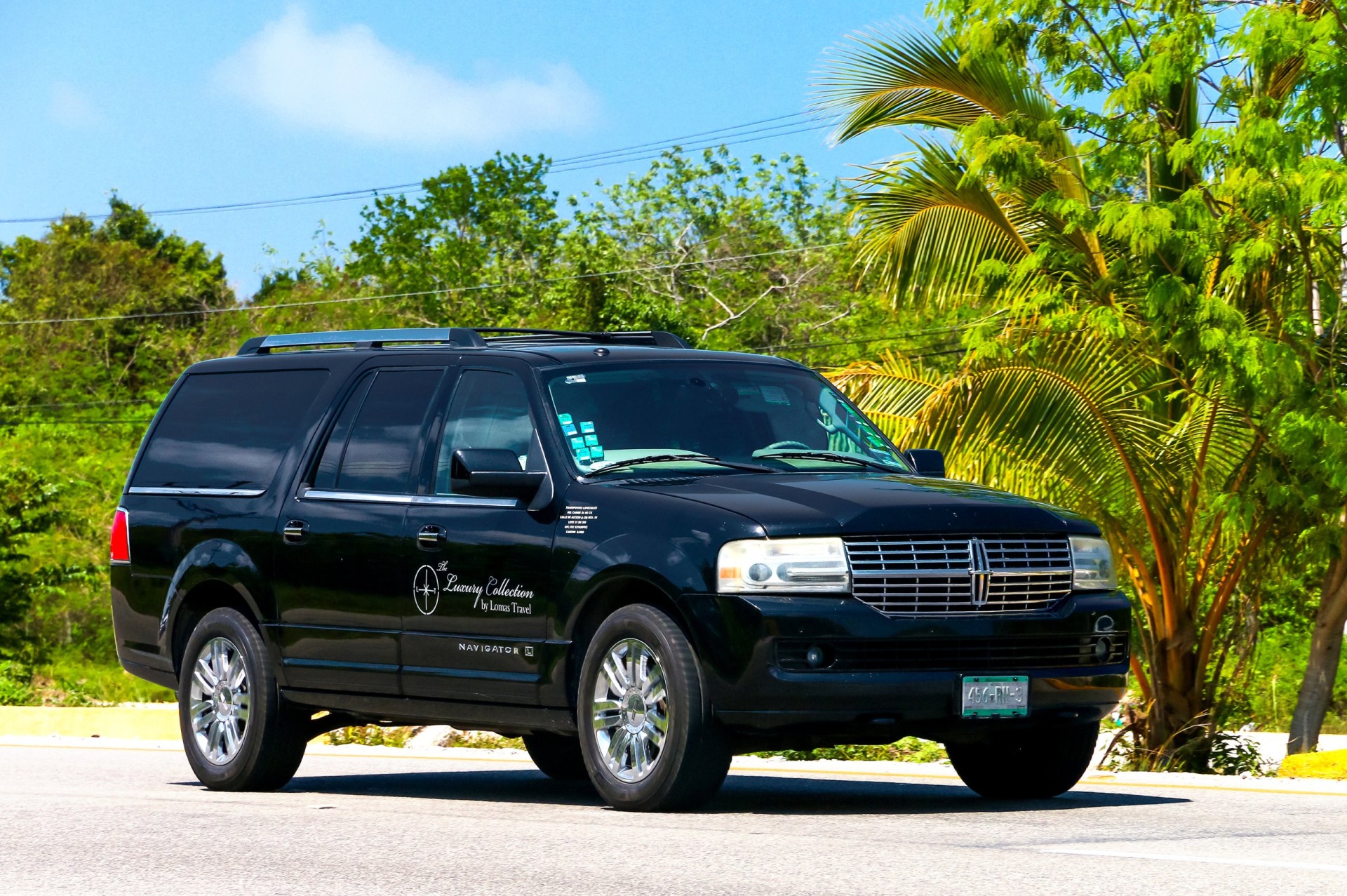
Unfortunately, the bad Lincoln Navigator years outnumber the good ones by almost two-to-one. This is primarily due to low FIXD Reliability Scores and avoidance of the trouble-prone first editions of a new generation. Depending on the model year, high repair costs and safety performance can also play a role in these verdicts.
Needless to say, we’ll skip the part of the conversation about market values and F.I.R.I.S. ratings, as you shouldn’t be wasting your time shopping for these Navigators. However, we’ll continue examining error codes, which is vital if you own one.
2001-2002 Lincoln Navigator
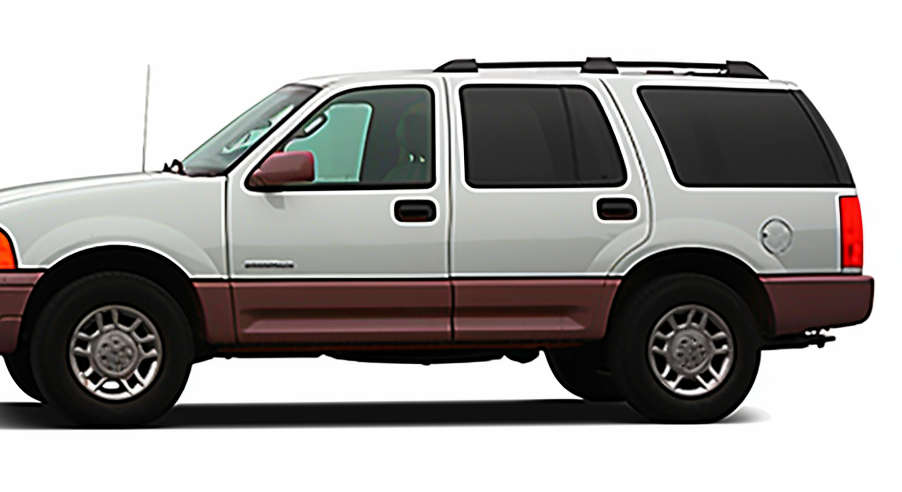
FIXD Reliability Score: 1-3/10
FIXD Internet Review Index Score (F.I.R.I.S.): 8.6-9.3/10
KBB Value: $2,932-$3,528
Fuel Economy: 12-13 mpg
RepairPal Average Annual Repairs Total: $$870-$1,333
Safety Rating: 3.5/5
The 2001-2002 model years represent the bottom-of-the-barrel Lincoln Navigators. Not only do they have very low FIXD Reliability Scores (the 2002 edition is ranked 1 out of 10), but poor showings in NHTSA safety testing (3.5 out of 5) aren’t inspiring either. Seeing fuel economy ratings of 12-13 MPG creates visions of a wallet emptying as quickly as the gas tank fills.
At $870, the annual upkeep for the 2002 Navigator is below average. However, the $1,333 in yearly repairs for the 2001 edition is 22% above average.
We’ll add that the 2001 Navigator is among the most recalled model years (six recalls), followed by the 2002 edition with four recalls.
In short, there’s not a lot to like about these Navigators.
As these Lincolns approach classic car status (which occurs after 25 years), no one will be surprised to see numerous check engine lights. In particular, codes P0171 and P0174 (lean fuel mixture) are common.
DTC P0442, an evaporative (Evap) emission control system leak, is also known to occur. At best, tightening or replacing the gas cap will take care of the issue. Otherwise, repairs can require replacing an Evap line ($50-$100), the Evap purge volume control valve, or the charcoal canister vent control valve ($150-$200). A new charcoal canister runs $200-$600.
2003, 2005-2006 Lincoln Navigator
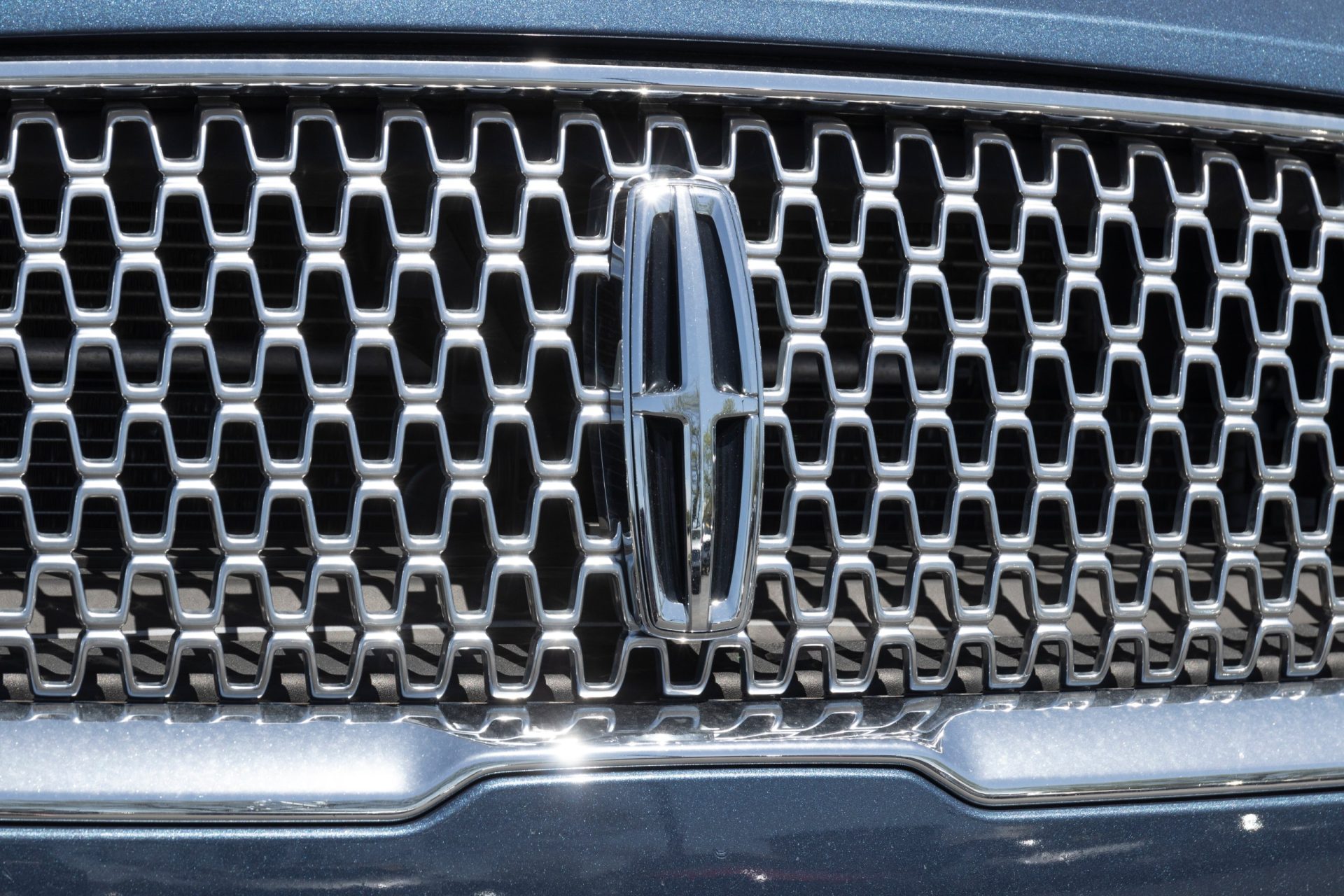
FIXD Reliability Score: 1/10
FIXD Internet Review Index Score (F.I.R.I.S.): 9.0-9.2/10
KBB Value: $3,098-$3,371
Fuel Economy: 13 mpg
RepairPal Average Annual Repairs Total: $750-$1,750
Safety Rating: 4.7-5.0/5
A FIXD Reliability Score of 1 (out of 10) says it all about the 2003 and 2005-2006 Lincoln Navigators. We’ll toss in that the 2003 edition is the debut of the second-generation Navigator and has the unfortunate distinction of having the worst annual maintenance and repair bill ($1,750). That’s a far cry from the $1,089 average, according to RepairPal.
Regrettably, strong safety scores (including a 5.0 for the 2003 Navigator) don’t matter much if you’re dealing with an unreliable vehicle. Further, there are three recalls for the 2006 edition and one recall for the 2003 Navigator. There are no official notices for the 2005 model year.
This collection of Navigators has a familiar cast of characters as far as error codes. The editions are known to have problems with DTCs P0420/P0430 (a faulty catalytic converter) and P0171/P0174 (lean fuel mixture). Engine misfires (P0300, P0303, and P0304) are common, too. Owners have to be ready for the associated repairs involving spark plugs, spark plug wires, vacuum leaks, ignition coils, fuel injectors, or fuel pumps.
2007-2010 Lincoln Navigator
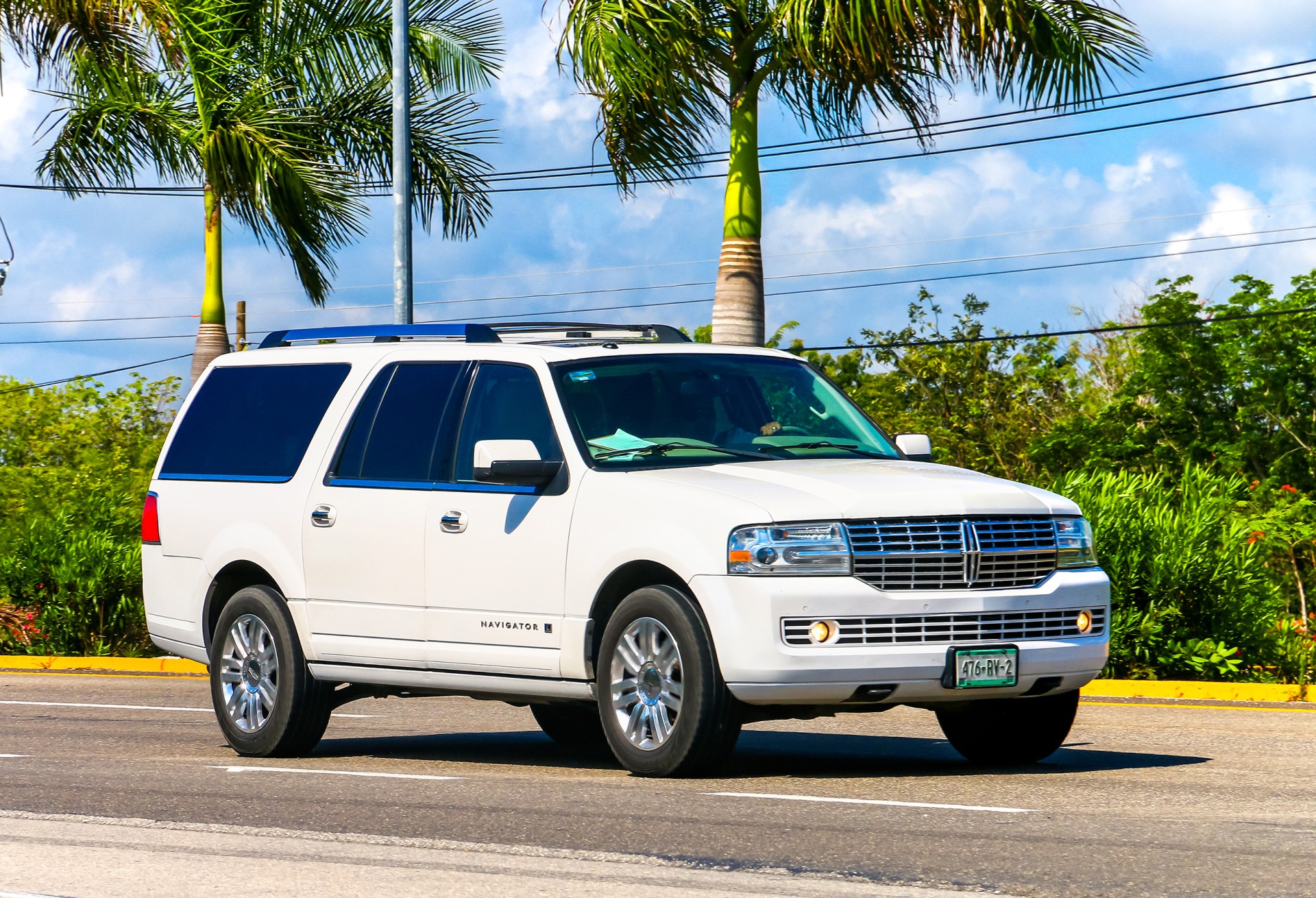
FIXD Reliability Score: 1-2/10
FIXD Internet Review Index Score (F.I.R.I.S.): 8.6-9.0/10
KBB Value: $4,982-$7,372
Fuel Economy: 14-16 mpg
RepairPal Average Annual Repairs Total: $745-$1,036
Safety Rating: 4.5-4.7/5
2007 marks the launch of the third-generation Navigator, and it’s not a pretty picture. A FIXD Reliability Score of 2 for most years (the 2009 is worse at 1) doesn’t scream dependability. And there’s no hard data that proves differently.
Reasonable fuel economy (14-16 MPG) and strong safety scores (4.5-4.7) are certainly appealing but do little to offset the low reliability rankings. At least annual maintenance and repair costs are below average.
Like other model years, the 2007-2010 Navigators are prone to the same problems, such as a bad catalytic converter (P0420/P0430) and fuel mixture issues (P0171/P0174).
However, the 2007 Navigator is troubling because FIXD sensor data shows that this Lincoln tends to have problems that don’t occur in the 2008-2010 model years. Specifically, codes P0138, P0152, and P0158 relate to faulty oxygen sensors. Often, a new oxygen or engine coolant temperature sensor ($150-$300) will solve the problem. Yet, a new catalytic converter can be required in some situations.
These Lincolns don’t escape recalls. There are two official notices each for the 2007 and 2008 Navigator. The 2009 model year has one recall (no recalls for the 2010 Navigator)
2013, 2017 Lincoln Navigator

FIXD Reliability Score: 1-3/10
FIXD Internet Review Index Score (F.I.R.I.S.): 8.9-9.3/10
KBB Value: $12,660-$26,387
Fuel Economy: 16-17 mpg
RepairPal Average Annual Repairs Total: $1,131-$1,166
Safety Rating: 4.0-4.6/5
The 2013 and 2017 are also part of the third generation, but they’re separated from the previous grouping because of being outliers. 2011 marked a turnaround for the third-gen Navigator, but the 2013 and 2017 editions failed to keep up with the improvements.
This starts with a FIXD Reliability Score of 3 for the 2013 Navigator. Such a low score isn’t an automatic disqualifier (the 2004 Navigator scores the same and s on the best years list), but the 2013 edition contrasts sharply with the 5 or 6 ranking from neighboring model years.
At the same time, there’s nothing saving the 2017 model year and its FIXD Reliability Score of 1. What’s especially disappointing is that the last year of model generation is usually among the best, but that’s not the case with the 2017 Navigator.
Better fuel economy, decent safety scores, and moderate upkeep expenses can’t counterbalance fundamental reliability concerns with the 2013 and 2017 editions.
Care to guess the most frequent DTCs for these Navigators? You’d be spot on if you cited catalytic converter-related problems (specifically, P0420 and P0430). Again, these vehicles are too new to have these types of issues, pointing to a potential problem with the component. FIXD sensor data also reveals that the 2017 Navigator has a history of error code P0131, another oxygen sensor-related matter.
Lastly, there are two recalls for the 2017 model year and none for the 2013 Navigator.
2018 Lincoln Navigator

FIXD Reliability Score: 8/10
FIXD Internet Review Index Score (F.I.R.I.S.): 8.5/10
KBB Value: $36,367
Fuel Economy: 18 mpg
RepairPal Average Annual Repairs Total: $1,250
Safety Rating: 4.6/5
Perhaps guilt by association isn’t the best method for determining a vehicle’s reliability. However, we have to consider Lincoln’s history of inadequate first editions of new-generation Navigators. 2018 is the debut year of the fourth generation. Call us overly cautious, but we just think there’s too much money at stake to take a chance on a vehicle with uncertain dependability.
Sure, there are many compelling characteristics of the 2018 Navigator, starting with a robust FIXD Reliability Score of 8. Others thought highly of this Lincoln, too—its F.I.R.I.S. ranking is 8.5. And no one will complain about 18 MPG mileage or a 4.6 safety score. Average repair costs aren’t unreasonable either.
Yet, we can’t shake off a concern for potential first-year troubles that can be difficult to solve.
In truth, there aren’t a lot of DTC codes for the 2018 Navigator—these are still newer vehicles. But the most frequent error message is a serious one: P0018, a problem with the intake camshaft position timing. Repairs could be modest, like replacing the oil control valve/variable valve timing control solenoid ($300-$400). However, a worst-case scenario requires engine replacement. Is that something you want to worry about?
We’ll close out our comments on the 2018 Navigator by mentioning that it’s subject to six recalls, tied with the almost-ancient 2001 model year for the highest number of recalls.
FAQs
What is considered high mileage for a Lincoln Navigator?
No hard and fast standard exists for assigning high-mileage status to a Lincoln Navigator. A look at online for-sale listings (autotrader.com, October 11, 2023) shows nationwide availability of 1664 second-hand Navigators. Of these, only 32 had 200,000 miles or more, and 66 had 150,000-200,000 miles.
So, less than 6% of these Navigators had at least 150,000 miles, suggesting a possible lifespan for these Lincolns. Could a Navigator go beyond 150,000 miles? Of course, and some do. But this appears to be the exception, not the rule.
Usage and upkeep also impact longevity. A poorly maintained vehicle driven hard in stop-and-go traffic isn’t likely to last as long as one well cared for with mainly highway mileage.
A pre-purchase inspection is the best determiner of a vehicle’s suitability for high mileage. A professional technician can identify potential trouble areas that might shorten a car’s longevity.
What other vehicles should I consider?
Lincoln enthusiasts wanting to stay within the brand can step up to a Navigator L, a stretch version of the standard Navigator. The automaker’s smaller offerings include the three-row Aviator, or the two-row Nautilus or Corsair. Stepping down to the Ford brand adds the Expedition to the list, which shares many components with the Navigator.
The natural head-on competitor to the Navigator is the Cadillac Escalade. Other General Motors offerings that come close are the Chevrolet Tahoe, Chevrolet Suburban, and GMC Yukon (including the extended Yukon L).
A Note About Data and Information Sources
This article has many details about Lincoln Navigator reliability; here’s what we used for our assumptions and recommendations.
- FIXD Reliability Score & Data: Engine reliability information is captured via the FIXD App.
The FIXD Reliability Score is calculated using the number of DTCs per year, weighted by mileage using 12,000 per year. This is then turned into a scale of 1-10 for easy graphing.
This is an objective score.
- F.I.R.I.S & Data: This data is the result of averaging the score of the Lincoln Navigator from Edmunds, KBB, Cargurus, and Cars.com.
Those individual Scores come straight from reviewers and owners of the Lincoln Navigator.
This is a subjective score.
From here, we translate the answers into the F.I.R.I.S as all the answers are out of 5.
Keep in mind that owners may think their car is more or less reliable than it actually is.
One potential problem is that people often buy the same make or model they are used to when they go car shopping, just a newer year.
Ford, for instance, has a number of consumer loyalty awards for the Ford F-Series, Ford Mustang, and Ford Expedition.
Car owners may be so loyal to the make or model they currently own that they would have trouble accurately comparing their cars’ reliability to others.
It’s for this reason that we ask car owners a question that is relative to mileage rather than relative to other cars.
Still, be mindful of the accuracy of these F.I.R.I.S; people’s perceptions and unconscious blindspots can skew data.
We suggest looking at both the FIXD Reliability Score and the F.I.R.I.S for this reason.
- KBB Value: Average private-seller valuations as supplied by Kelley Blue Book (KBB), based on a Lincoln Navigator with typical mileage for that respective model year.
- Fuel Economy: Mileage-per-gallon estimates according to the EPA MPG on Fueleconomy.gov
- Annual Maintenance/Repair: Upkeep expenses as reported by RepairPal
- Safety Rating: Crash test data collected and reported by NHTSA. We average all ratings for each year to come up with a simplified, average safety score. This makes it easier to look at on a graph.
References
- Lincoln Navigator model-specific information, edmunds.com (various dates). Retrieved October 11, 2023, from https://www.edmunds.com/
- Model-specific recall information as per the National Highway Transportation Safety Administration. Retrieved October 11, 2023, from https://www.nhtsa.gov/recalls“

Dave Goldberg is an automotive journalist and lifelong car fanatic. He writes for numerous enthusiast and business outlets and is an ongoing contributor to HotCars.com, one of the most popular car culture websites. When he’s not writing or driving, Dave is either under a hood or asleep. His credentials include a BA in Journalism from The George Washington University.

